|
|
|
At the start of September 1980, I had found my first job, by hiring on as a screen printer at a local Kansas City Print Company. Having studied a variety of Graphic Arts techniques while in college, I was somewhat familiar with this application and soon became proficient enough to satisfy my employer. By the end of September 1980, I had attended the finest event of the year, at arguably the finest battlefield west of the Mississippi River.
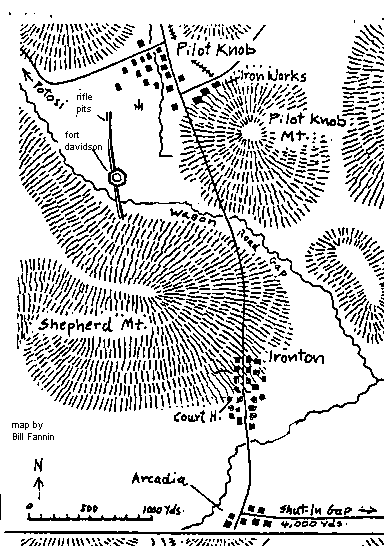 Once again, I found myself in the company of Steve Lillard and Richard Savage - this time on a trip to southeast Missouri. We had the Napoleon smoothbore hitched to Steve's van as we hit the highway that Friday evening of September 26th. The further southeast we went, the more hills there were to traverse, as well as winding two lane country roads. It was after midnight, I'd guess by the time we arrived at Pilot Knob, a little town smack dab in the middle of the Arcadia valley. A somewhat mountainous area of Missouri this was, although the elevation of some of the neighboring peaks barely exceeded 500 feet. (I will not bore you with the history of the area, nor the story of the 1864 battle. Several excellent sources can be found elsewhere, including Cyrus A. Peterson's Pilot Knob, the Thermopylae of the West and Jay Monaghan's Civil War on the Western Border)
Once again, I found myself in the company of Steve Lillard and Richard Savage - this time on a trip to southeast Missouri. We had the Napoleon smoothbore hitched to Steve's van as we hit the highway that Friday evening of September 26th. The further southeast we went, the more hills there were to traverse, as well as winding two lane country roads. It was after midnight, I'd guess by the time we arrived at Pilot Knob, a little town smack dab in the middle of the Arcadia valley. A somewhat mountainous area of Missouri this was, although the elevation of some of the neighboring peaks barely exceeded 500 feet. (I will not bore you with the history of the area, nor the story of the 1864 battle. Several excellent sources can be found elsewhere, including Cyrus A. Peterson's Pilot Knob, the Thermopylae of the West and Jay Monaghan's Civil War on the Western Border)
It was too dark to see, but across the street from the PILOT KNOB MOTEL and RESTAURANT was the Fort Davidson State Park. With our limited vision , we could see an assortment of activity going on at this late hour. Individuals with candle lantern's or flashlight's passing in the night- from car to campground with the possessions that would sustain them for the next 48 hours. Tents, wooden camp boxes, wooden tables, clothing,and in some cases sleeping bags and coolers. The familiar 'tink-tink-tink' of tent stakes at several locations continuing into the night as more and more reenactors rolled into the area. Pilot Knob was billed as the BIG SHOW in Missouri, so there would hopefully be a strong turnout of reenactors from all over the state, and possibly Iowa and Illinois.
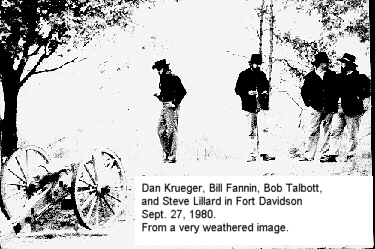 If I recall correctly the Federal artillery people camped within the fort itself, as well as most of the Federal infantry also. I know we had to unhitch the Napoleon, and roll it into the fort that night. Making it difficult, besides being pitch black with only the faint glow from the motel lights to see by (or a hand held lantern), was the fact there was about an eight foot wide entrance (called a sally port) at the northwest end of the fort to wheel the cannon though. In we got it, wheeling it to its proper place near the eastern end of the fort.
If I recall correctly the Federal artillery people camped within the fort itself, as well as most of the Federal infantry also. I know we had to unhitch the Napoleon, and roll it into the fort that night. Making it difficult, besides being pitch black with only the faint glow from the motel lights to see by (or a hand held lantern), was the fact there was about an eight foot wide entrance (called a sally port) at the northwest end of the fort to wheel the cannon though. In we got it, wheeling it to its proper place near the eastern end of the fort.
( I promised not to bore you with historical details, but I most mention the appearance of Fort Davidson. It was a hexagonal shaped earthen structure, about nine feet in height and half as wide as a football field. A moat ten feet in width by seven feet in depth surrounding the structure. Cannon could be mounted on the parapet, or lip of the fort with a field of fire of 900 yards in every direction).
Besides Steve's cannon, their would be three other federal guns this weekend. The batteries of Mark Tolliver, Don Calvin, and Hal Hamilton. We were on site for the briefest on moments, when Don Calvin informed us that his cannon was still in Washington, MO-this side of St. Louis because he didn't have a trailer-and could we please retrieve it for him. I don't know why I volunteered, but myself, Richard Savage, Don Calvin and his son all piled in Steve's van to make the journey to Washington. I tried to snatch a little sleep along the way, but it was nearly impossible-the van taking the narrow Missouri country roads like a mad roller coaster ride. By the time we got to Washington, had hitched Don Calvin's gun aboard the trailer and returned to Pilot Knob, it was near dawn. It was Saturday, September 27th. It would be a LONG day until rest came again.
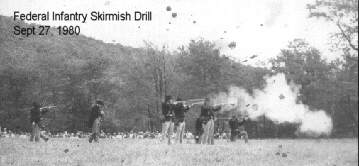 Not sure what went on during the morning; infantry and artillery drill I'm sure. Gregg Higginbotham was here by now; he may have come in during the night - not sure. Right after the noon meal, it came time for the battle . I had been asked to bring my musket and my infantry stuff (by now I had a cartridge box and canteen).I also had a Billy Jack hat that I had purchased at Disneyland way back about 1973 when I was in the Navy, stationed in San Diego. At home, I had soaked the hat in a sink of hot water to lose its shape. Then after slapping it against the wall a time or two, and stomping on it, I had myself a pretty good slouch hat that I took to Pilot Knob.
Not sure what went on during the morning; infantry and artillery drill I'm sure. Gregg Higginbotham was here by now; he may have come in during the night - not sure. Right after the noon meal, it came time for the battle . I had been asked to bring my musket and my infantry stuff (by now I had a cartridge box and canteen).I also had a Billy Jack hat that I had purchased at Disneyland way back about 1973 when I was in the Navy, stationed in San Diego. At home, I had soaked the hat in a sink of hot water to lose its shape. Then after slapping it against the wall a time or two, and stomping on it, I had myself a pretty good slouch hat that I took to Pilot Knob.
There were only about 50 federal infantry and since the artillery part of the battle would not be used until the conclusion of today's battle, Higginbotham and I were volunteered to march with the boys. The federals were preparing to march to Ironton about 2 miles south (historically, the little town of Ironton was were the two opposing forces butted heads and the battle started). I was happy to see that once again we would be commanded by Dickson Stauffer. Also in the ranks were Ray Hamm, Boyd Wilson, Bill Fannin and some others that I recall meeting at Glasgow just 2 months past. They all seemed pleased at the reacquaintance as flesh was pressed all around. I remembered the drill from Glasgow, so I quickly fell into step as we headed out of camp. Once out of sight of Fort Davidson, and because we were following a hard trail that paralleled the railroad -Dick gave us the order to route step. We could carry our weapons any way we wanted to and did not have to stay in step; sort of shuffle along.
If you've been to Pilot Knob, you know that once you leave the park and head southeast, the road becomes graveled. Loose rock and shale all over the landscape; the result of many years of mining. Then a march up a slight elevation to cross a set of railroad tracks that bisect the valley north and south. Dick had us then turn south onto a narrow country lane (a road that roughly paralleled the railroad tracks), and we proceeded directly to Ironton.
We ambled down the lane like we were on a Sunday stroll in the park. Everyone was having their own gabfest; making merry of the day or telling bawdy jokes to pass the time. Occasionally a break would be called and some of the men would step out of ranks to empty their bladders. While the terrain to our right was rough and woodsy, we passed several houses on our left perched contentedly on the slight rise of Shepherd's Mountain. People were outdoors of some of those houses, waving to us good-naturedly from their porch swings or in lawn chairs. Kids on their bikes sped up and down the road, sometimes getting in our way.
It was said that Boyd Wilson was a hell of a beer drinker. (I can confirm that from observing him at Glasgow) It was rumored that Boyd had carried a cold six pack at a July 4th event in Independence and during a particular lull in the battle, crawled under the 24 Hwy bridge to indulge himself. During the march to Ironton, he offhandedly remarked that he would step into the first tavern he saw, and we could pick him up on the way back. In fact, I'm not quite sure he didn't do just that.
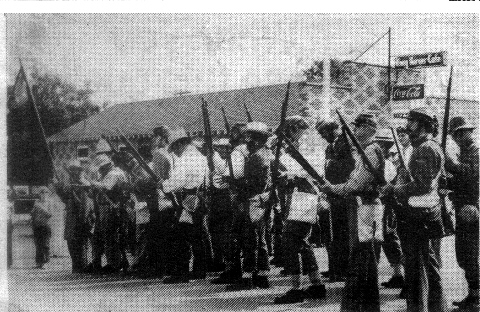 After a spell, we entered the little burg of Ironton, the county seat of Iron County. We had loaded our muskets and come to shoulder arms by now. Dick decided to divide our forces, so he sent first platoon, under John Zaharias, to march up a side street to guard against any cavalry (the two platoons would march southward together, and in line of sight with one another-in theory). Dickson's 2nd platoon (with yours truly) continued down main street, past shops,liquor stores, places of business. I think the entire population of Ironton was in attendance, as both sides of the street testified. As we neared the courthouse, about midtown, we commenced to hear a commotion, then a midget mountain howitzer made its appearance about a block away. Four butternut clad scarecrows pushed/pulled the tiny popgun into place, and fired it right up at us. Then a ragged line of infantry appeared from around the corner of a local cafe, fired an equally ragged volley at us and hollered that unholy gargle which is the rebel yell.
After a spell, we entered the little burg of Ironton, the county seat of Iron County. We had loaded our muskets and come to shoulder arms by now. Dick decided to divide our forces, so he sent first platoon, under John Zaharias, to march up a side street to guard against any cavalry (the two platoons would march southward together, and in line of sight with one another-in theory). Dickson's 2nd platoon (with yours truly) continued down main street, past shops,liquor stores, places of business. I think the entire population of Ironton was in attendance, as both sides of the street testified. As we neared the courthouse, about midtown, we commenced to hear a commotion, then a midget mountain howitzer made its appearance about a block away. Four butternut clad scarecrows pushed/pulled the tiny popgun into place, and fired it right up at us. Then a ragged line of infantry appeared from around the corner of a local cafe, fired an equally ragged volley at us and hollered that unholy gargle which is the rebel yell.
Dick would have none of this crap. John Z was given the word to take his people back towards Pilot Knob, retrace the entire 2 miles back, stopping at the vital railroad crossing before Fort Davidson. Dick felt his platoon could hold the advancing sesech infantry as we retreated, as long a ' Z ' held the crossing to prevent us being cut off by the sesech cavalry. ( You see, the terrain makes it extremely difficult to be flanked by the enemy-particularly horse soldiers. To reach our flanks, the enemy would have to go around the mountain or through impossible brush. The third and best option was to follow the railroad tracks to where they intersected with the country road.)
So ' Z ' and his boys started off at a trot. The rest of us slowly gave ground, firing blistering volleys at the butternut mob. Several loud kids and boys on their bicycles were following us and they occasionally got in the middle of things. In fact, most of the population of Ironton seemed to be 'tagging' along and remained very close as if they were following the Pied Piper to Hell. We didn't want to smoke an innocent, even if they were "IN OUR FREAK'N WAY!", so a mutual cease fire by both parties was observed. The important thing now was to get back to the fort in one piece and hope first platoon was ready to cover our ass'.
To make a long story short, when we reached the railroad crossing, the first platoon was nowhere to be found. Instead we were greeted by Shelby's Fifth Missouri Cavalry, who had rode along the railroad tracks (remember option 3) and were in ambush; blazing at us with their pistols. We were too exhausted from the 2 mile retreat to put up much of a resistance and we were easily picked off. The gray clad horse soldiers rode rings around us, whooping and hollering firing their six shooters in the air. When their circus act was over (and every pistol they owned had been emptied), a halt was called by their commander-Doug Sloan and we were allowed to limp back to the fort with our tails between our legs. Once inside Fort Davidson, Dickson discovered that 'Z' had misunderstood the orders to fall back. It was assumed they were to go all the way back to the fort.(I should mention that by now a huge audience of spectators had appeared, positioned on both the north and south sides of the battlefield and held back by a rope. There must have been several thousand at least).
However, we didn't have time to play the blame game, nor to rest our laurels. The confederate infantry had arrived and was in position to assault the fort. They would charge from the east, and have to cross open field in order to reach us. I was pretty tired from my duties as an infantryman, but now I was obligated to jump to my position as number 1 man on the cannon. Don't know what Steve and Richard Savage had been doing while Hig and I were in Ironton; probably having a picnic under the shade of a tree. Now all was business. All four artillery pieces were in position and spaced about 20 yards apart on the parapet of the fort.
We could see the butternuts as they formed a long line of about 100 men. They fired a couple of ragged volleys from long distance as if testing our defenses. After a brief pause in which they commenced to holler and beat their chest's like wild gorillas- the noise rising to a fever pitch- the whole of them began to dash across the field at us. Well, this is what we'd been waiting for. We opened such a artillery fire that echoed across the whole Arcadia Valley. Smoke and noise that hadn't been heard in over a hundred years. We fired our cannon's individually and as a whole; the wind was whipping the gun smoke over to the spectator area or clinging to the tree branches.
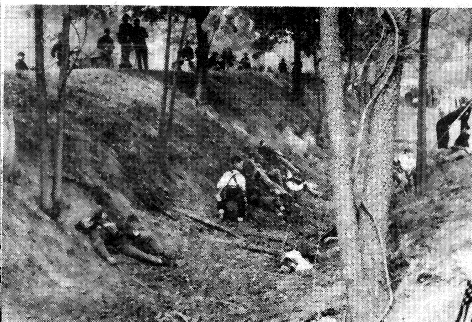 The reb infantry attempted a total of three charges against the fort. Some made it to the moat at the bottom of Fort Davidson, where they were picked off by federal infantrymen. A few even managed to scale the very wall of the fort, but were quickly overwhelmed and captured. I used my rammer as a club against one unlucky butternut, but merely pushed him down hill with it. Steve had a smoking pistol in his hand from his own individual battle with the enemy. At one point, exhaustion overcame me and Steve relieved me of my duty. I fell down and sucked on a canteen, while the battle petered out around me. Before long, the fighting ceased all together. The dead and dying lay over the field in front of us. The rest of the enemy limped off into the brush. After a moment, someone played taps and those of us still standing, removed our hats. Then in a loud voice,"RESURRECTION DAY!" all the dead and wounded picked themselves from the ground. As the "casualties" began dusting themselves off- retrieving dropped muskets or hats, there was a thunderous applause from the spectators. It was a fine day all around, because this was the first time I had been a part of a performance that played out in front of thousands of people. They really appreciated this recreation of their local history.
The reb infantry attempted a total of three charges against the fort. Some made it to the moat at the bottom of Fort Davidson, where they were picked off by federal infantrymen. A few even managed to scale the very wall of the fort, but were quickly overwhelmed and captured. I used my rammer as a club against one unlucky butternut, but merely pushed him down hill with it. Steve had a smoking pistol in his hand from his own individual battle with the enemy. At one point, exhaustion overcame me and Steve relieved me of my duty. I fell down and sucked on a canteen, while the battle petered out around me. Before long, the fighting ceased all together. The dead and dying lay over the field in front of us. The rest of the enemy limped off into the brush. After a moment, someone played taps and those of us still standing, removed our hats. Then in a loud voice,"RESURRECTION DAY!" all the dead and wounded picked themselves from the ground. As the "casualties" began dusting themselves off- retrieving dropped muskets or hats, there was a thunderous applause from the spectators. It was a fine day all around, because this was the first time I had been a part of a performance that played out in front of thousands of people. They really appreciated this recreation of their local history.
That evening, Dickson spoke of rallying all the Missouri federal units into one organization. As this was 1980, there was a unit in Springfield/Joplin area, one in Columbia/Jeff City area, one in St. Louis area, and several loose individuals scattered all about. Each individual unit did it's own local stuff and had its own elected officers and NCO's. What Dick proposed was to combine these localized groups into as one LARGE group and go to 2-3 events a year. To avoid confusion over who had seniority at which event, Dick also proposed a seperate set of elected officers and NCO's for that LARGE group. This only pertained to the infantry. The artillery groups could maintain what rank they please. Whether it was because of the popskull that was served that night or because we had won the battle- everyone was in a good mood and unanimously ratified the proposal. While still in this mood, the first elections were held. Dick Stauffer became captain, Mike Singer became lieutenant, Ray Hamm became first sergeant for an organization that would soon be called Holmes Brigade.
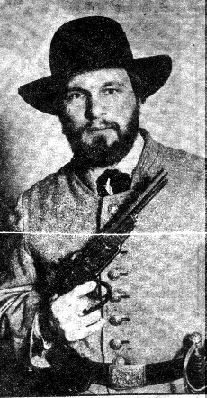 Immediately following this, it was decided that more popskull was needed. Directly northwest from the fort, a beer garden was set up. A local country/western band was set up on a makeshift stage; their music sounding like someone strangling a cat. All the locals from town were here, as well as quite a few reenactors wanting to wash the dust out of their throats with Budweiser in a tin cup. I saw Steve Lillard conversing with a strange fellow, so I went over to say hello. The fellow introduced himself as Jay Jackson, commander of Crowley's Clay County Company. Jay was wearing a federal issue sky blue great coat that I greatly admired. He said he made all the uniforms for Crowley's and would gladly make me a greatcoat for about $80. I promised I would make arraignments to see him this winter, at his home in Gladstone (just north of KC), concerning the coat. Both Jay and Steve were quite intoxicated meanwhile and had been making lewd remarks about a well endowed local woman in tight blue jeans, who was just out of ear shot. Next thing I know is, Jay goes over to the woman and bites her on her ass. Well, she spins around and empties two cups of beer right on top of Jay's head.
Immediately following this, it was decided that more popskull was needed. Directly northwest from the fort, a beer garden was set up. A local country/western band was set up on a makeshift stage; their music sounding like someone strangling a cat. All the locals from town were here, as well as quite a few reenactors wanting to wash the dust out of their throats with Budweiser in a tin cup. I saw Steve Lillard conversing with a strange fellow, so I went over to say hello. The fellow introduced himself as Jay Jackson, commander of Crowley's Clay County Company. Jay was wearing a federal issue sky blue great coat that I greatly admired. He said he made all the uniforms for Crowley's and would gladly make me a greatcoat for about $80. I promised I would make arraignments to see him this winter, at his home in Gladstone (just north of KC), concerning the coat. Both Jay and Steve were quite intoxicated meanwhile and had been making lewd remarks about a well endowed local woman in tight blue jeans, who was just out of ear shot. Next thing I know is, Jay goes over to the woman and bites her on her ass. Well, she spins around and empties two cups of beer right on top of Jay's head.
This really concludes what I consider the highlights of my first Pilot Knob event. Sunday was a repeat of the Battle for Fort Davidson, except no trip to Ironton. We just fired our guns with the same results as the day before. This was the finest event of the year, and I maintain the finest battlefield west of the Mississippi for me to participate in. Since that weekend of September 1980, I have been to Pilot Knob every third year (as it rotates with two other State events: Lexington and Athens-both in Missouri). While each succeeding Pilot Knob since 1980 has been larger in scale and numbers, the one I hold the most fondness for is my first.